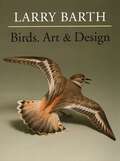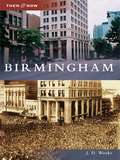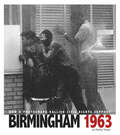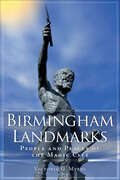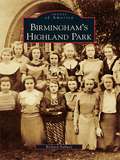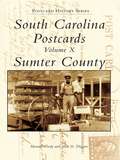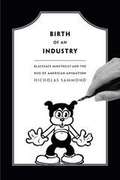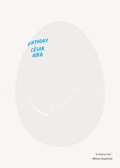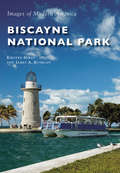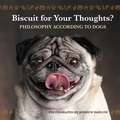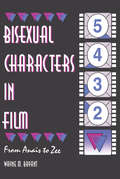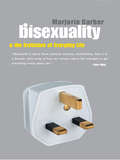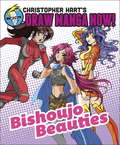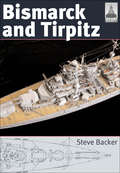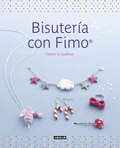- Table View
- List View
Birds, Art & Design
by Larry BarthLegendary bird carver Larry Barth has created a stunning retrospective of his life's work, including sculptures from museum exhibits and rarely seen pieces from private collections. This is a must-have book for every bird lover, carver, and anyone who appreciates fine sculptural art.
Birds, Bees & Blossoms: A step-by-step guide to botanical and animal watercolour painting
by Harriet De WintonIn her second book, botanical artist Harriet de Winton shows you how to paint modern watercolour artworks to treasure and share. Picking up where New Botanical Painting left off, this books aims to expand readers' repertoires into fauna as well as flora, with easy-to-follow instructions for a variety of difficulty levels.Through more than 30 step-by-step projects, you'll discover how to paint beautiful butterflies, bumblebees, birds and botanicals from around the world. In the final chapter, you'll find a guide to composing stunning patterns and scenes with your own botanical watercolour creations. Use your new skills to make art for your wall, unique cards, invitations, or simply paint for pleasure.Projects include: Bengal TigerChilean FlamingoPrickly PearZebraBumblebeeGarden Tiger MothPeacockWhite-tailed DeerPolar BearArctic PoppyAnd many more!
Birmingham
by J. D. WeeksBirmingham's surrounding hills comprise the only place in the world with a plentiful supply of all the ingredients for iron making. This spurred the city of Birmingham's charter in 1871 around the crossing of two railroads. The city's development into a leading industrial center is shown here in photographs and postcard views, some a century old.
Birmingham 1963: How a Photograph Rallied Civil Rights Support (Captured History)
by Shelley Tougas Kathleen Baxter Alexa SandmannIn May 1963 news photographer Charles Moore was on hand to document the Children’s Crusade, a civil rights protest. But the photographs he took that day did more than document an event; they helped change history. His photograph of a trio of African-American teenagers being slammed against a building by a blast of water from a fire hose was especially powerful. The image of this brutal treatment turned Americans into witnesses at a time when hate and prejudice were on trial. It helped rally the civil rights movement and energized the public, making civil rights a national problem needing a national solution. And it paved the way for Congress to finally pass laws to give citizens equal rights regardless of the color of their skin.
Birmingham Broadcasting
by Tim HollisBirmingham, Alabama, has enjoyed a long and distinguished broadcasting history. The city's first radio station aired in 1922, and television arrived in 1949. Both media produced personalities who became household names in the city. Audiences came to know Joe Rumore, Tommy Charles, Country Boy Eddy, Cousin Cliff Holman, Rosemary, Pat Gray, Tom York, and many others as if they were members of their own families. Even the commercials became as memorable as the news, entertainment, talk, and children's shows they interrupted.
Birmingham Food: A Magic City Menu (American Palate)
by Emily BrownBirmingham began as a boomtown filled with immigrants who held on to the best recipes from their homelands. More recently, locals like Frank Stitt and Carole Griffin helped transform the modern southern city into a foodie destination with the best of national trends. Andrew Zimmern visited with his show Bizarre Foods America to tout one of the city's most popular food trucks, Shindigs. Fast casual dining is done with care, and gems like Trattoria Centrale and Bettola are dedicated to local ingredients. Join food writer and restaurant enthusiast Emily Brown as she details the delectable history of food in the Magic City.
Birmingham Landmarks: People and Places of the Magic City (Landmarks)
by Victoria MyersThough the landscape has certainly changed, many of Birmingham�s early landmarks�testaments to the steelworkers who built the city after the Civil War, as well as those who have since prospered here�remain. In Birmingham Landmarks, Alabama native Victoria Myers explores the Magic City�s most prominent industrial and cultural features. Step back in time to discover Rickwood Field, one of America�s oldest baseball parks, and the Carver Theater, the only venue that allowed African Americans to view first-run movies before the civil rights movement. Find out why Birmingham is known as the Pittsburgh of the South at Sloss Furnaces and learn the secrets of Vulcan, who was commissioned for the 1904 World�s Fair and has become one of the state�s most recognizable monuments.
Birmingham in Vintage Postcards (Postcard History Series)
by J. D. WeeksAt the start of the 20th century, Birmingham was one of the fastest growing cities in the South, sometimes referred to as the "Magic City." It began as a town located at the intersection of two railroads and then quickly expanded and took in neighboring communities. Around this time, photographers traveled around the United States taking photographs of towns and cities and turning the photographs into postcards. The postcards collected here show historic Birmingham's downtown, hospitals, parks, communities, schools, hotels, and industries. These images serve as a record of everyday life in this bustling Southern city.
Birmingham's Highland Park
by Richard DabneyBirmingham's Highland Park originated in the 1880s when a grand boulevard was dug and three lush parks were planned at the northern foothills of Red Mountain. This boulevard was Highland Avenue, at the time the widest street in the South. The development, built within three miles of the center of Birmingham, included the construction of a resort hotel and lake. A dummy line rail system conveyed the populace of The Magic City" out to the beautiful Highland Park neighborhood, where in summer the air was both cooler and cleaner. Although Highland Avenue was lined with mansions of every architectural style, only 12 remain today. Indeed, some Highland Park dwellers have resided for generations in this neighborhood of true character and charm."
Birmingham's Theater and Retail District (Images of America)
by Tim HollisFrom the 1890s to the 1970s, the thriving area of Birmingham between Eighteenth and Twenty-first Streets along First, Second, and Third Avenues was the bustling heart of this quickly growing city. Before the age of the shopping mall, the downtown was the center of retail and entertainment in Birmingham. Along these streets, entrepreneurial immigrants built department stores--including Pizitz and Loveman, Joseph, and Loeb--while the marquees of the Alabama, Ritz, and Lyric theaters, among others, shined over the busy downtown sidewalks.
Birth Figures: Early Modern Prints and the Pregnant Body
by Rebecca WhiteleyThe first full study of “birth figures” and their place in early modern knowledge-making. Birth figures are printed images of the pregnant womb, always shown in series, that depict the variety of ways in which a fetus can present for birth. Historian Rebecca Whiteley coined the term and here offers the first systematic analysis of the images’ creation, use, and impact. Whiteley reveals their origins in ancient medicine and explores their inclusion in many medieval gynecological manuscripts, focusing on their explosion in printed midwifery and surgical books in Western Europe from the mid-sixteenth to the mid-eighteenth century. During this period, birth figures formed a key part of the visual culture of medicine and midwifery and were widely produced. They reflected and shaped how the pregnant body was known and treated. And by providing crucial bodily knowledge to midwives and surgeons, birth figures were also deeply entangled with wider cultural preoccupations with generation and creativity, female power and agency, knowledge and its dissemination, and even the condition of the human in the universe. Birth Figures studies how different kinds of people understood childbirth and engaged with midwifery manuals, from learned physicians to midwives to illiterate listeners. Rich and detailed, this vital history reveals the importance of birth figures in how midwifery was practiced and in how people, both medical professionals and lay readers, envisioned and understood the mysterious state of pregnancy.
Birth of a Nation (SparkNotes Film Guide)
by SparkNotesBirth of a Nation (SparkNotes Film Guide) Making the reading experience fun! SparkNotes Film Guides are one-stop guides to great works of film–masterpieces that are the foundations of filmmaking and film studies. Inside each guide you&’ll find thorough, insightful overviews of films from a variety of genres, styles, and time periods. Each film guide contains:Information about the director and the context in which the film was made Thoughtful analysis of major characters Details about themes, motifs, and symbols Explanations of the most important lines of dialogue In-depth discussions about what makes a film so remarkable SparkNotes Film Guides are an invaluable resource for students or anyone who wants to gain a deeper understanding of the great films they know and love.
Birth of an Industry: Blackface Minstrelsy and the Rise of American Animation
by Nicholas SammondIn Birth of an Industry, Nicholas Sammond describes how popular early American cartoon characters were derived from blackface minstrelsy. He charts the industrialization of animation in the early twentieth century, its representation in the cartoons themselves, and how important blackface minstrels were to that performance, standing in for the frustrations of animation workers. Cherished cartoon characters, such as Mickey Mouse and Felix the Cat, were conceived and developed using blackface minstrelsy's visual and performative conventions: these characters are not like minstrels; they are minstrels. They play out the social, cultural, political, and racial anxieties and desires that link race to the laboring body, just as live minstrel show performers did. Carefully examining how early animation helped to naturalize virulent racial formations, Sammond explores how cartoons used laughter and sentimentality to make those stereotypes seem not only less cruel, but actually pleasurable. Although the visible links between cartoon characters and the minstrel stage faded long ago, Sammond shows how important those links are to thinking about animation then and now, and about how cartoons continue to help to illuminate the central place of race in American cultural and social life.
Birth of the Binge: Serial TV and the End of Leisure (Contemporary Approaches to Film and Media Series)
by Dennis BroeBirth of the Binge: Serial TV and the End of Leisure describes and details serial television and "binge watching," the exceedingly popular form of contemporary television viewing that has come to dominance over the past decade. Author Dennis Broe looks at this practice of media consumption by suggesting that the history of seriality itself is a continual battleground between a more unified version of truth-telling and a more fractured form of diversion and addiction. Serial television is examined for the ways its elements (multiple characters, defined social location, and season and series arcs) are used alternately to illustrate a totality or to fragment social meaning. Broe follows his theoretical points with detailed illustrations and readings of several TV series in a variety of genres, including the systemization of work in Big Bang Theory and Silicon Valley; the social imbrications of Justified; and the contesting of masculinity in Joss Whedon’s Buffy the Vampire Slayer, Firefly, and Dollhouse. In this monograph, Broe uses the work of Bernard Stiegler to relate the growth of digital media to a new phase of capitalism called "hyperindustrialism," analyzing the show Lost as suggestive of the potential as well as the poverty and limitations of digital life. The author questions whether, in terms of mode of delivery, commercial studio structure, and narrative patterns, viewers are experiencing an entirely new moment or a (hyper)extension of the earlier network era. The Office, The Larry Sanders Show, and Orange Is the New Black are examined as examples of, respectively, network, cable, and online series with structure that is more consistent than disruptive. Finally, Broe examines three series by J. J. Abrams—Revolution, Believe, and 11.22.63—which employ the techniques and devices of serial television to criticize a rightward, neo-conservative drift in the American empire, noting that none of the series were able to endure in an increasingly conservative climate. The book also functions as a reference work, featuring an appendix of "100 Seminal Serial Series" and a supplementary index that television fans and media students and scholars will utilize in and out of the classroom.
Birthday
by César AiraBirthday is among the very best of Aira—it will surprise readers new to his work, and will deeply satisfy his many fans Before you know it you are no longer young, and by the way, while you were thinking about other things, the world was changing—and then, just as suddenly you realize that you are fifty years old. Aira had anticipated his fiftieth—a time when he would not so much recall years past as look forward to what lies ahead—but the birthday came and went without much ado. It was only months later, while having a somewhat banal conversation with his wife about the phases of the moon, that he realized how little he really knows about his life. In Birthday Aira searches for the events that were significant to him during his first fifty years. Between anecdotes ,and memories, the author ponders the origins of his personal truths, and meditates on literature meant as much for the writer as for the reader, on ignorance, knowledge, and death. Finally, Birthday is a little sad, in a serene, crystal-clear kind of way, which makes it even more irresistible.
Bisbee
by Annie Graeme LarkinVisually, the Bisbee of today remains a community frozen in time, with Main Street retaining its character from 1910. The discovery of copper deposits in the Mule Mountains brought forth a wealth that enabled a substantial community. Profitable mining ventures and a need for labor drew thousands of miners from around the world to work in Bisbee. These individuals added a distinct flavor to the area. Like countless other Western mining camps, Bisbee evolved from a rough frontier community surviving disastrous fires and floods into a town with a substantial population and solid foundation. Bisbee's seemingly inexhaustible mineral wealth resulted in the community becoming a center of economic and political power in an emerging territory on its way to statehood. It was Arizona's greatest copper camp.
Bisbee
by Ethel Jackson PriceIn the early 1900s, it was the largest city between St. Louis and San Francisco, bustling with the raw material of Wild West legends. Bisbee's infamous Brewery Gulch once supported 47 saloons and was considered the "liveliest spot between El Paso and San Francisco." By the 1970s, opportunists had relieved Bisbee's Mule Mountains of billions of pounds of copper, 102 million ounces of silver, 2.8 million ounces of gold, and millions of pounds of zinc, lead, and manganese. The ore reserves were depleted, and when the last pickaxe struck plain old dirt, a mass exodus of miners collapsed the real estate market. But the lure of cheap land was a magnet for retirees, hippies, and artists. Boarding houses were converted into charming bed and breakfasts. Antique stores, galleries, cafes, and restaurants replaced the saloons. These days, a vibrant and eclectic community of ranchers, politicians, and free spirits; a well-preserved architectural and historic heritage; and "the most perfect year-round climate" make Bisbee, the county seat, a one-of-a-kind gem.
Biscayne National Park (Images of Modern America)
by James A. Kushlan Kirsten HinesBiscayne National Park protects the larger portion of south Florida�s Biscayne Bay, a uniquely tropical lagoon harboring crocodiles, manatees, dolphins, and Caribbean fish. Tropical trees cover its islands, while the world�s fourth-longest coral reef sits offshore. Native Americans lived here thousands of years ago; the Spanish held it for 200 years. Hundreds of ships foundered on the reef, fueling a lucrative wrecking industry. In the late 1800s, hardy homesteaders created an agricultural and fishing community. In the 1920s and 1930s, it became a playground for the newly rich and famous. Bracketed by Miami and Key Biscayne to the north and Key Largo to the south, the nearby population eventually grew to over 2.5 million residents and over 14 million annual visitors. To protect these unique natural and historical resources and to assure its enjoyment by future generations, a half century ago, the federal government created Biscayne National Monument, which later became Biscayne National Park.
Biscuit for Your Thoughts?: Philosophy According to Dogs
by Andrew DarlowDiscover pearls of human wisdom reinterpreted through the eyes of utterly adorable canines in this book packed with adorable dog photos.Your inner dog is calling.Take off the leash.Dogs have mastered the art of living the good life. Every day is a glorious adventure. Every blade of grass is new, and every squeak from their toy is as sweet-sounding as the last. In Biscuit for Your Thoughts?, these practitioners of canine zen impart their wisdom, cultivated over thousands of years, to help us mere humans better deal with the rigors of our bipedal lives.Praise for Biscuit for Your Thoughts?“Darlow (CandidCanine.com) offers ninety-five pages of wonderful photos coupled with short thoughts.” —William Hageman, The Chicago Tribune“The ultimate dog lover prized possession. . . . Filled with smile-inducing photos and quotes galore, this book is a nicely priced present any time of year.” —Carol Bryant, Editor, FidoseofReality.com“Andrew Darlow’s amazing photos instantly elevate your mood along with captions that prove how dogs touch our lives immensely and give us the right outlook on life.” —Sheryl Matthys, The Dog Lovers Matchmaker and Founder & Author of Leashes and Lovers“The perfect book for any dog lover’s x-mas stocking!” —Ada Nieves, Co-Chair and Creative Director for the New York Pet Fashion Show “Andrew expertly photographed these dogs in their cutest moments.” —Laurel Kate Sittig, Creative Director, Photojojo.com
Bisexual Characters in Film: From Ana's to Zee
by Wayne M BryantHow far have we progressed from the days when showing a film such as Jack Smith’s Flaming Creatures landed the cinema’s programmer, projectionist, and ticket taker in jail? What are some of the hidden clues modern audiences are overlooking in older films that suggest a character’s bisexuality? Which famous actors, actresses, directors, and screenwriters were attracted to people of both sexes? In Bisexual Characters in Film, the first book to focus on the role of bisexual characters in film, you’ll find answers to these questions and many more as you explore, analyze, and celebrate 80 years of bisexual movie characters (and the people who have created them) from around the world. A lively, entertaining, and informative commentary, this book examines the treatment of bisexual film characters and shows you how that treatment has been affected by societal forces such as censorship, politics, religious prejudices, homophobia, and sexual stereotypes. Bisexual Characters in Film looks at the contribution of bisexual people (and others who have had lovers of varying sexes) to the body of work available on film today. These include the directors, writers, actors, composers, and designers whose sexual orientation has informed their work. An analysis of the Motion Picture Production Code and its devastating effect on bisexual and homosexual screen images forms an important part of the book. You learn how, specifically, it eradicated gay, lesbian, and bisexual characters from Hollywood films as well as the role of bisexual, lesbian, and gay filmmakers in finally defeating it. Other questions you’ll find answers to include: Who, or what, is a bisexual? How were bisexual characters represented in silent film, before the forces of censorship banned them from the screen? What bisexual myths and stereotypes are portrayed on film? What is the role of “camp” in bisexual film?Bisexual Characters in Film is a unique resource for researchers; librarians; film festival planners; the queer media; professors and students of lesbian, gay, and bisexual studies; bisexual activists; and general bisexual, gay, lesbian, and transgendered readers. It provides a much-needed view of bisexual representations in a major segment of our popular culture.
Bisexuality and the Eroticism of Everyday Life: Bisexuality And The Eroticism Of Everyday Life
by Marjorie Garber"Bisexuality is about three centuries overdue . . . nevertheless, here it is: a learned, witty study of how our curious culture has managed to get everything wrong about sex."-Gore Vidal
Bishop
by Brendan Vaughan Pam Vaughan Laws Railroad MuseumLocated in the stark landscape of Eastern California's Owens Valley, Bishop is situated between two of the highest mountain ranges of the contiguous United States. Native Americans had been in the region since antiquity, and white settlers began to filter in after many battles with the Paiutes and Shoshones. Bishop was named after Sam Bishop, who drove cattle into the area and settled along Bishop Creek. Many more farmers and ranchers followed. To the south, Los Angeles was growing too, tapping the Owens River for a gravity-fed aqueduct for its residents; thus began the Los Angeles-Owens Valley Water Conflict.
Bishoujo Beauties: Christopher Hart's Draw Manga Now!
by Christopher HartFocusing on the glamorous, over-the-top female characters of the bishoujo genre, Bishoujo Beauties teaches readers how to draw the alluring eyes, flowing hair, and stylish outfits that define "bishie" characters. After an introduction to the basics, readers will have a chance to follow along Hart's in-depth step-by-steps, and will even be invited to draw on their own, right in the book's pages.
Bismarck and Tirpitz: Bismarck And Tirpitz (Shipcraft Ser. #Vol. 10)
by Steve BackerA treasury of useful facts, plans, and photos for modelers. The ShipCraft series provides in-depth information about building and modifying model kits of famous warship types. Lavishly illustrated, each book takes the modeler through a brief history of the subject class, highlighting differences between sister-ships and changes in their appearance over their careers. This includes paint schemes and camouflage, featuring color profiles and highly detailed line drawings and scale plans. The modeling section reviews the strengths and weaknesses of available kits, lists commercial accessory sets for super-detailing of the ships, and provides hints on modifying and improving the basic kit. This is followed by an extensive photographic gallery of selected high-quality models in a variety of scales, and the book concludes with a section on research references—books, monographs, large-scale plans, and relevant websites. This volume covers the famous German sister-ships whose fates were so very different—Bismarck had a short but glorious career, first sinking HMS Hood and then in turn being sunk by the Home Fleet, whereas the Tirpitz spent most of the war skulking in Norwegian fjords, fending off attacks by midget submarines and carrier aircraft before being finally sunk by enormous, specially designed bombs dropped by RAF Lancasters.
Bisutería con Fimo
by Carine Le GuillouxUn libro con más de 40 tutoriales con fotografías e instrucciones paso a paso para diseñar y realizar bisutería con Fimo®. ¡Diseñar tu propia bisutería nunca ha sido tan sencillo! El Fimo® es una pasta muy versátil, ideal para hacer bisutería y abalorios. Es muy fácil de trabajar: se moldea con las manos y se cuece en el horno hasta endurecerse. En este libro encontrarás más de 40 modelos de bisutería en pasta Fimo®, con instrucciones detalladas y fotografías explicativas paso a paso. En pocos minutos diseñarás collares, anillos, pulseras, pendientes, broches e incluso pasadores para el cabello. ¡Manos a la masa!
